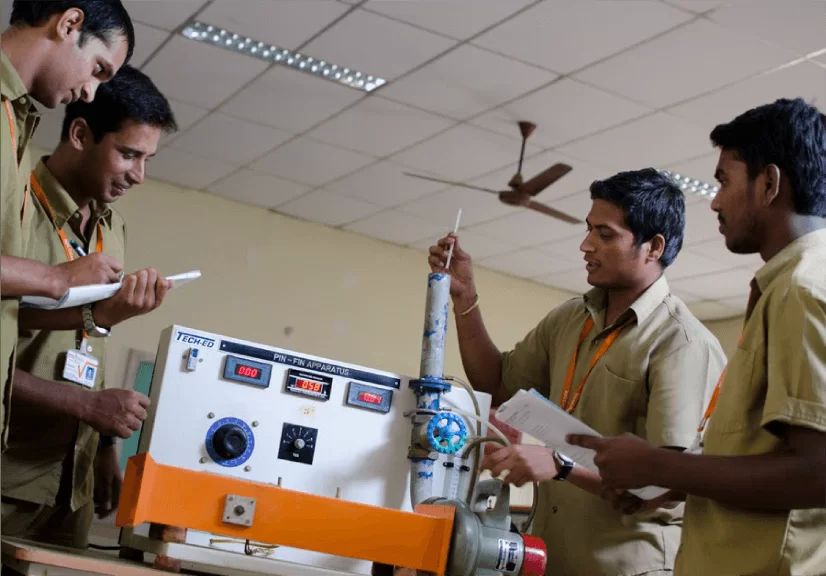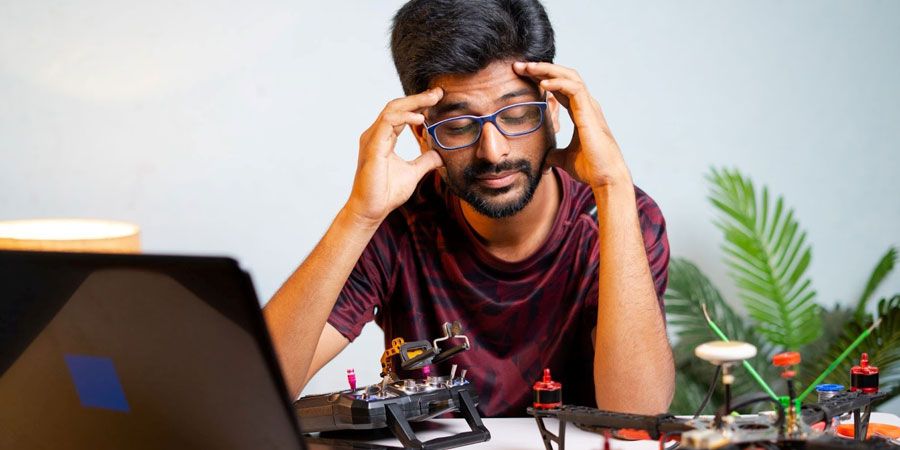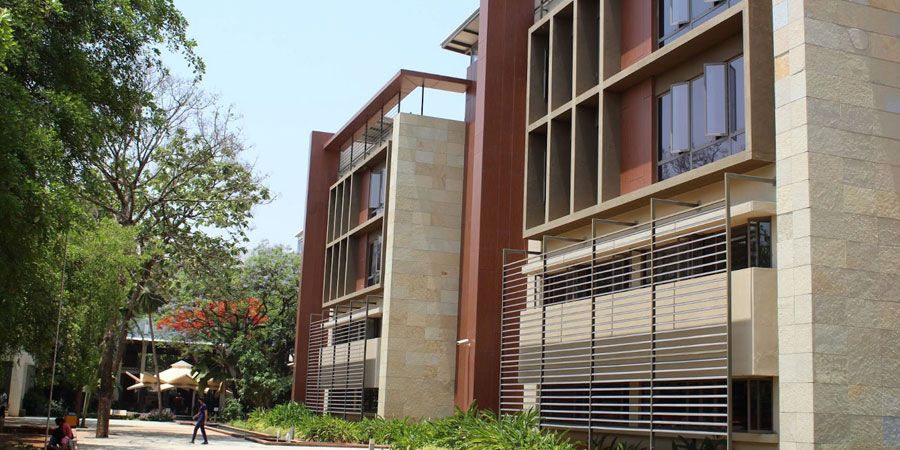How To Become an Aeronautical Engineer After 12th In India
Feb 27, 2024
Understanding Aeronautical Engineering
If you want to become an aeronautical engineer in India, its scope is vast. There are a variety of opportunities in aviation and space industries. That said, to excel, you need strong skills in physics and mathematics. Now, let's dig deep and unpack more on how to become an aeronautical engineer after the 12th. Today, the average salary for an aeronautical engineer is about 30,00,000 rs per year.
Eligibility Criteria
The first step towards becoming an aeronautical engineer is to join the top Aeronautical Engineering colleges in Bangalore. Therefore, let’s understand the eligibility requirements so you are on the right page.
Educational Requirements
This is how you become an aeronautical engineer and graduate with a B.Tech in Aeronautical Engineering.
For undergraduate admission, you need a minimum of 50-55% aggregate marks in PCM (Physics, Chemistry, Mathematics) in Class 12. The admission is based on JEE Main and JEE Advanced scores.
Some institutions may have specific age criteria for admission to the undergraduate program. Therefore, you must cross-check with the institute.
Entrance Exams
As aforementioned, most top Aeronautical Engineering colleges in Bangalore will check JEE, JEE Advanced, or KCET scores for admission along with the marks you scored in class 12.
JEE:
JEE Main is the first level of the exam and is conducted by the National Testing Agency (NTA). It is held twice a year, in January and April. The exam includes multiple-choice questions (MCQs) and numerical value-based questions. Subjects covered in JEE Main include Physics, Chemistry, and Mathematics.
JEE Advanced:
JEE Advanced is the second stage of the examination. Only candidates who qualify in the top percentile of JEE Main are eligible to appear for JEE Advanced. It is considered one of the most challenging engineering entrance exams. The exam pattern includes multiple-choice questions, numerical answer-type questions, and comprehension-based questions.
KCET:
KCET is an entrance exam for colleges in Karnataka, including B.Tech in Aeronautical Engineering in Bangalore. Like JEE, this exam consists of multiple-choice questions and the subjects covered include Physics, Chemistry, Mathematics, and Biology, depending on the course applied for. Candidates should have completed their 10+2 or equivalent examination with relevant subjects to appear in the exam.
BITSAT:
BITSAT is conducted for admission to various undergraduate programs offered by BITS Pilani. The exam tests candidates in Physics, Chemistry, Mathematics/Biology, English Proficiency, and Logical Reasoning. The questions are in multiple-choice format.
Candidates should have completed their 10+2 or equivalent examination in Physics, Chemistry, and Mathematics. Interested candidates need to fill out the BITSAT application form during the specified application period. BITSAT is conducted at various exam centers in India and abroad.
Choosing the Right College and Course
Now, let’s say, you meet the eligibility requirements and have scored perfect marks in your entrance exam. What’s the next step? Jumping onto the first college that offers you admission won’t help you become the best aeronautical engineer. Instead, you must choose the right program along with the specializations and electives to support your journey. Take a look!
Bachelor's Degree Programs
Various colleges and universities in India offer undergraduate programs in aeronautical engineering, which focuses on aircraft and spacecraft design. Prominent institutions like the Indian Institutes of Technology (IITs), National Institutes of Technology (NITs), and other top aeronautical engineering colleges in Bangalore also provide these programs.
When selecting a college, factors like accreditation, faculty expertise, infrastructure, and placement opportunities are crucial. So, make sure you look for colleges accredited by relevant authorities to ensure quality education.
Next, experienced faculty with industry exposure is important to enhance learning. Well-equipped labs and modern infrastructure help with practical learning. Lastly, examine the college's placement records and industry connections to help you out.
Specializations and Electives
Some of the specializations you will study in your B.Tech in aeronautical engineering include:
Aircraft Transportation Systems: It is the study of understanding how aircraft move efficiently and safely from one place to another.
Aerospace Propulsion: Studying the engines and methods that make aircraft fly.
Aerodynamics: Figuring out how air behaves and affects things that move through it, and is especially crucial for designing aircraft.
Fluid Dynamics: Exploring how liquids and gases move and is especially important for understanding air flows around aircraft.
Communication: Learning how to create effective communication systems inside aircraft.
Instrumentation: Designing and using instruments in aeronautical applications.
Navigational and Guidance Control Systems: knowing systems that guide and control how aircraft move during flight.
Aircraft Materials: Finding and using the right materials for building strong and durable aircraft.
Electronic Systems: Focusing on the electronic parts and systems that make aircraft work.
Ground Vehicle Systems: Studying systems related to how aircraft move and operate on the ground.
Electives:
You now know the specializations of aeronautical engineering. While it may slightly differ, the core subjects and objectives remain the same. Some of the electives in aeronautical engineering include:
Advanced Aerospace Structures
It focuses on studying and designing sophisticated structures for high-tech aircraft. This includes materials, construction methods, and technologies to enhance the structural integrity and performance of aircraft.
Advanced Propulsion Systems
It examines and explains propulsion systems that enable aircraft to achieve higher velocities. This could involve advanced engines, propulsion technologies, and systems that contribute to increased speed and efficiency.
Computer Integrated Manufacturing
It covers the use of computers in controlling and optimizing the manufacturing processes related to aircraft production. This involves integrating computer systems to streamline and enhance the efficiency of manufacturing operations.
Computational Fluid Dynamics
It involves the use of computational methods to analyze and simulate the behavior of fluids, particularly air, around aircraft. This includes studying thermal loads, structural loads, noise, combustion, and other factors influencing aircraft performance.
Civil Aviation Requirements
It focuses on the regulatory and environmental requirements that aircraft must meet. This includes standards related to CO2 emissions, aviation fuels, and other factors set by various regulatory bodies to ensure safety, efficiency, and environmental responsibility.
Fundamentals of Combustion
It is the study of the basic principles of combustion, which is crucial for aircraft propulsion. This includes studying chemical kinetics, thermodynamics, and other related concepts that contribute to the combustion processes powering aircraft engines.
Renewable Energy for Aeronautical Engineering
It teaches you the applications of renewable energy sources in aeronautical engineering. This could involve the development and integration of sustainable energy technologies to power or supplement aircraft systems.
Gaining Practical Experience
During and after your engineering program, it is necessary to gain practical experience for a successful career.
Internships and Training Programs
Many aeronautical engineering programs in India have collaborations with aerospace companies and research institutions. You have the opportunity to undertake internships during their academic breaks or as part of your curriculum. These internships provide hands-on experience in real-world aerospace projects You can apply your theoretical knowledge in practical scenarios. Some of the top organizations offering internships include DRDO, ISRO, and HAL.
Projects and Research Work
Projects and research work are important aspects of your aeronautical engineering program. They are a part of your overall evaluation. It is usually in the final year when you will have to complete project work.
Career Opportunities and Growth Prospects
Let’s understand the career opportunities you can embark on as an aeronautical engineer.
Job Roles in Aeronautical Engineering
After graduating in Aeronautical Engineering, you can work as a flight mechanic, aircraft production engineer, or in roles like assistant aircraft engineer and air safety officer. Also, you can pursue a postgraduate degree through exams like GATE, which opens up advanced career paths.
Aeronautical engineers enjoy attractive career opportunities abroad as well. Many foreign universities offer scholarships for postgraduate Aeronautical Engineering programs, which makes it an appealing option for those seeking higher education and well-paid jobs overseas.
Further Education and Specializations
Some further education options after aeronautical engineering include:
- Master of Technology (M.Tech) in Aeronautical Engineering
- Master of Science (M.S) in Aerospace Engineering
- Doctor of Philosophy (Ph.D.) in Aerospace Engineering
- M.Tech in Aeronautical Engineering
- Master of Business Administration (MBA)
- Master of Technology (M.Tech) in Aerospace Engineering
- Doctor of Philosophy (Ph.D.) in Aeronautical Engineering
- Master of Engineering (M.E) in Aeronautical Engineering
- Master of Technology (M.Tech) in Aeronautics
Essential Skills and Traits
Lastly, let’s understand a few essential skills you must possess to get into aeronautical engineering.
Technical Skills
Acquiring technical skills is necessary for entering aeronautical engineering. You must be proficient in areas such as aerodynamics, aircraft design, propulsion systems, and computer-aided design (CAD) is essential. Understanding materials, structural analysis, and knowing about the important software tools used in aerospace engineering are also crucial for success in this field.
Soft Skills
Soft skills like effective communication, teamwork, problem-solving, etc., are important. You will need to collaborate and communicate complex ideas. Also, soft skills help maintain professionalism, making you a well-rounded and valuable contributor to the aerospace industry.
The Final Word
These are some of the important things you must keep in mind if you want to pursue aeronautical engineering. Follow your passion with robust determination and embrace any challenges as opportunities to learn and grow. Your dedication to understanding the subject and having a practical approach makes all the difference. However, your journey begins with a top aeronautical engineering college in Bangalore.
FAQS
What are the educational requirements to become an aeronautical engineer in India?
To become an aeronautical engineer in India, you must complete 12th and pass entrance exams like JEE, KCET, etc.
Which entrance exams should I prepare for after 12th grade to pursue aeronautical engineering?
You must prepare for JEE along with the entrance exam of the state. For instance, particular states and even collages have their own entrance exam.
How can I choose the right college and course for aeronautical engineering?
Research accredited institutions, faculty expertise, curriculum, and placement opportunities before selecting a institute.
What practical experience opportunities are available for aeronautical engineering students?
You can always seek internships with aerospace companies like DRDO and HAL.
What are the key skills and traits required for success in the field of aeronautical engineering?
Key skills include proficiency in aerodynamics, strong problem-solving abilities, teamwork, effective communication, etc,








